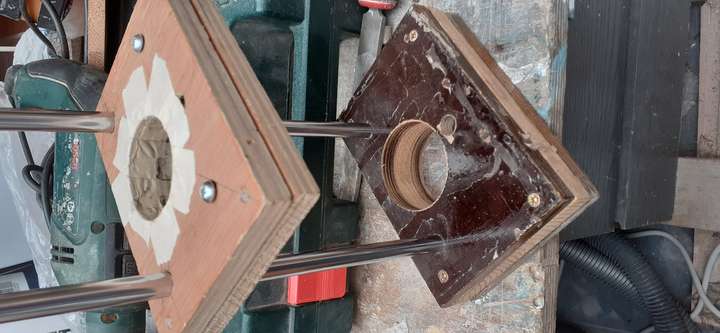Making a Portable Drill Stand

I have slowly discovered my general ineptitude for holding a drill vertical - it can be up to 5 degrees off vertical even when I'm trying to be really careful. I don't mind for thin pieces of wood, but on thicker pieces where I am drilling a through hole, this amounts to a very poor un-aligned exit.
To make the transom plate, my father in law suggested I oversize the holes, then fill with resin before drilling out the size I want - to avoid water ingress into the wood (ruining the colour). Given it is almost 2cm thick, I really want these holes to be perpendicular. If a hole is misaligned, I could drill through the outside of my resin plug, thus negating its purpose.
I went to the effort of making a jig because I found that you can buy one for not much money, but it won't come for a week and I really want to get on with the job at hand.
I have tried a couple of ways to make the jig. Firstly, I tried a configuration as on items available to purchase - two slider bars, with the drill in the middle. Next I tried to make one which was a tripod arrangement - three slider bars with the drill in the middle. I thought that the second option would be more naturally stable, but it just jammed all the time when I was trying to use it, so I've parked that idea.
To ensure the jig was accurate, I marked and drilled the identical plate out of thinner material, then screwed them together to make a thicker piece. This allowed for a subtle adjustment, but also meant that my holes were nearer accurate to start - which is important because otherwise the jig will drill lots of identical incorrect holes.
I hoped to use the jig without a seat for the back of the drill since the one at the nose end is so substantial, but sadly, the drill still wobbles about too much and its natural settled position is, I discovered, a few degrees off vertical due to the drill seat sagging on the rails under the weight of the drill (this is why I wanted a tripod initially).
Note that it might have worked better if the rails were central to the drill spindle, but when I made this originally, I was planning on the tripod idea, only my measurements mistake prevented this.
With the seat at the back of the drill, I've discovered the drill glides smoother along the rails, and when checked with a square, the drill bit is always vertical. Just how far off the drill naturally drifted is clear by the large hole in the base - this was drilled as the first use of the stand without the rear drill seat, and it is almost 5mm from the correct position at the top. Luckily its 56mm (my largest hole saw), so I doubt I'll be touching the sides any time soon.
The rear seat of the drill is a bit annoying being loose fitted, it would be better attached to the front seat, but, then it will take longer to put the drill in and out. I use the drill a lot so I want to minimise this time. I've found I can hold onto the rear seat with my thumb while controlling the drill, but ultimately, I've opted for a piece of nylon cord that holds the front and rear plates together, tensioned by hooking over a screw. This can be released to allow sliding the rear plate away and thus remove the drill.
The advantage of the setup I have is the entire thing can be disassembled and placed in a drawer, taking up very little space indeed (certainly much less than a commercial offering).
If I make this again (yes a 3rd time!), I'll make the base more like my tripod attempt where it had a piece of wood protruding out further so I could more easily attach a clamp. I made this deliberately compact, but it is a bit of a squeeze to fit a quick release clamp so the drill will still slide far enough down to drill through my work.


